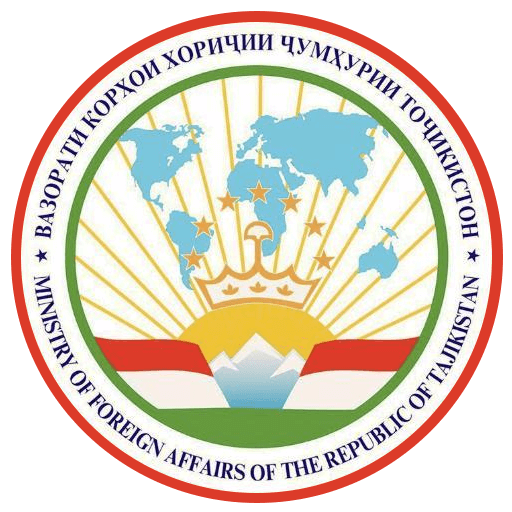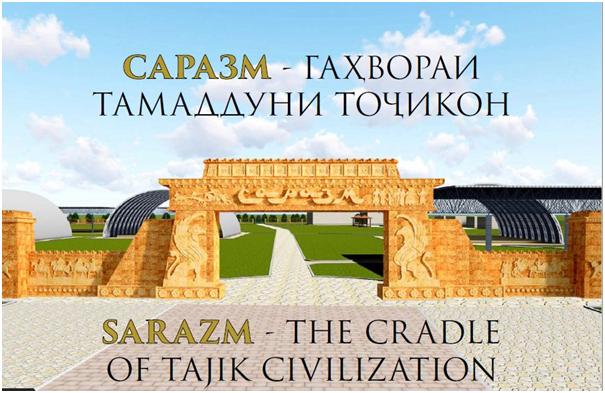Distinguished Compatriots,
Ladies and Gentlemen,
With a great honor I would like to congratulate the glorious people of my country, including the people of the ancient city of Panjakent, which is not only the birthplace of the great Tajik-Persian poet – the humanity’s poet Abuabdullo Rudaki, but also a cradle of the ancient history of the Tajik people, on our holy national holiday – the 29th anniversary of our state independence and on the 5500th anniversary of Sarazm.
Reverence for the sweet and poetic Tajik language, glorious history and culture, revival of good ancestral customs and traditions, promotion of ancestral heritage and protection of tangible and intangible heritage of the Tajik people became the possibility for the glorious people of Tajikistan thanks to independence and freedom.
In the contemporary times, especially in an environment, where the clash between civilizations and different cultural values is intensifying, it is possible to withstand the destructive effects of globalization only through an in-depth study of history and the promotion of rich historical and cultural heritage.
I would like to emphasize that the love towards the beloved Motherland stems from the knowledge of the glorious history and instructive past of the nation. Indeed, the ancient history of the Tajik people and the precious tangible and intangible heritage of the past, including historical sites, is the greatest school of self-education for every member of society, especially teenagers and young people. The task of scientists, scholars, teachers and parents is to explain to the younger generation the importance of this great heritage and to encourage and guide them to study the ancient and glorious history of our people.
Today, there are 3000 historical sites in our country, each of which attracts the attention of famous domestic and foreign scientists, tourists and guests.
Ancient sites, including Kuldara, Khonaqoh, ancient Sarazm, Takhti Sangin, Ajinateppa, ancient Panjakent, Hulbuk, Bunjikat, Shahriston, Hisorak, Sanjarshoh, Karon, Yamchun and dozens of other places are annually explored through domestic and international ethnographic expeditions.
Sarazm is one of such ancient sites. The meaning of this historical name is “where the land begins”, which is a strong proof of the glorious and ancient history of the Tajik people. We have accomplished many activities to preserve this great historical heritage since independence.
As early as in 2000, the Government issued its resolution declaring Sarazm site – a center for the formation of Tajik civilization, handicrafts and urban planning – as a historical and archeological reserve. I visited this place twice in 2003-2005, got acquainted with its situation and mandated the responsible persons to protect and study this unique place.
Though the country had scarce financial resources in those days, we have allocated the necessary funds for the protection of this unique site. As a result, its five excavation areas were covered with a roof and the site was fanced during 2003-2008.
In this process, historical and archeological materials and scientific evidence on the basis of research by domestic and foreign scientists were submitted to inscribe Sarazm into the UNESCO World Heritage List. Thus, this reputable organization inscribed Sarazm into the list of the most unique sites of universal culture on July 31, 2010. Then, the Government adopted its relevant resolutionon on celebration of the 5500th anniversary of Sarazm, which is recognized by scientists and the international community as a center for the formation of Tajik agricultural, handicraft and urban planning. This document ensured a lot of landscaping and infrastructure development activities carried out in the city of Panjakent, and today we witness the city’s beautiful image, and its residents together with all the people of Tajikistan enjoying the celebration of their ancient homeland.
Taking this opportunity, I would like to welcome all scientists and researchers and participants of the International Symposium “Sarazm – the beginning of the Tajik civilization of agriculture, handicrafts and urban planning” to beautiful Tajikistan and the ancient city of Panjakent.
The Sarazm ancient city site was discovered in 1976 by the Tajik archeologist Abdullojon Ishakov. The results of scientific research on this historical site have been discussed at many international scientific conferences and fora in Tajikistan, Russia, the United States, France, Germany, Italy, Kazakhstan, Uzbekistan, Moldova, Kyrgyzstan and African countries.
Sarazm is a unique site of the Eneolithic and Bronze Ages in Central Asia, which covers the period from the 4th to the 3rd millennia BCE and in some regions up to the 2nd millennium BCE. Historians believe that the formation of two pure models of economy and culture in Central Asia – a stable form of agriculture and field livestock – completed, and the most important historical process – the formation of production, including agriculture, animal husbandry and handicrafts – began during this period.
The first serious research on the study of the Eneolithic and Bronze Age sites in the territory of contemporary Tajikistan was conducted in the 50s of the last century in the territory of Qairoqqum and Beshkent valley. Later, Bronze Age artifacts were found in Istaravshan, the middle and lower reaches of the Vakhsh River and other parts of Tajikistan.
During the independence, other Bronze Age artifacts were discovered in Kangurtut, Teguzak, Dahana, as well as in the middle and lower reaches of the Vakhsh River, the Hisor Valley, and more recently in Farkhor, which is currently being studied by specialists.
The ancient town of Sarazm is geographically the northernmost cultural and agricultural settlement in Central Asia, and the civilization of Sarazm has lasted for almost 1500 years. Until 1980, the site was visited by famous archeologists Alexander Belenitsky, Vadim Mason, Boris Litvinsky, Rauf Munchaev, Boris Marshak, Ahmadali Askarov, Numon Nematov, Philippe Coll, Karl Lamberg-Karlovsky, Henri Paul Francfort and Bertil Leone.
Since then, Sarazm has become one of the leading research centers by world-class specialists. Since 1984, foreign centers of science and archeology, first ad foremost, French scientists Henri Paul Francfort and Roland Bezenwall, and a year later American researchers Philippe Coll and Karl Lamberg-Karlovsky, as well as Russian researchers Natalia Vinogradova, Vadim Mason and Lyubov Kircho joined the studies.
The comprehensive study of Sarazm site has been ongoing since 1984, during which Tajik scholars with their French, Russian, Chinese, Italian and American colleagues have studied the full history of the site, taking into account various aspects of life in its territory.
The resolution to celebrate the 5500th anniversary of Sarazm gave a new impetus to a completely new period of research and study of this unique site. In this regard, archeological excavations and preparation of excavations for the celebration have been scaled up, and a large number of domestic and foreign archaeologists have been involved in its study.
It is important to note that Sarazm is one of the oldest centers of agricultural, handicraft and urban development not only in Central Asia, but also the entire Middle East region – Afghanistan, Iran, Pakistan and India. Therefore, the scientific community rightfully considers the culture of Sarazmians as the beginning and the foundation of civilization of agriculture, handicrafts and urban development in the basin between the Sirdaryo and Amudaryo rivers. Our distant ancestors, before choosing the site of Sarazm as their permanent residence, may have taken into account the main factor – abundance of water resources and vast soft soils.
Sarazm was the birthplace of the first architects of the Varorud region, and to date more than 150 houses, 4 fire temples, a granary and a cottage have been discovered under the ground. The discovered objects of this ancient city testify to the high interest in the urban culture of our ancestors, and we see the beginning of the formation of the urban culture of our ancestors on the basis of the architectural and construction art of Sarazm. At the end of the fourth millennium BCE, the city of Sarazm was also known as one of the major centers of metal production. The upper mountains of Zarafshon rich in copper, gold, silver, lead, tin and other minerals facilitated the development of this craft.
Indeed, today the territory of Panjakent is one of the largest gold and copper mining areas in Tajikistan. Archaeological excavations have uncovered a variety of mining tools, as well as molds for casting tools and weapons, including more than 300 units of copper, bronze, lead, silver and gold tools.
The Tajik scholars’ studies proved that Sarazm inhabitants have mastered more than 40 types of handicraft. Archaeological finds testify to the cultural and commercial ties of Sarazm with the present-day territories of Afghanistan, Pakistan, India and other lands. Development of trade relations during transition period lasting from the 4th to 3rd millennia has evolved Sarazm into one of the centers of cultural integration in the ancient world.
As early as in 1981-1991 Tajik, Russian, American and French scholars and archaeologists estimated 5 500-year history of Sarazm. American and French archaeologists have dated foundation of Sarazm to 5899-5765 and 5775-5364 respectively, and Tajik and Russian scholars amounted it to 5600-5500. These dates have been studied and confirmed based on the radiocarbon and chemical analysis in the laboratories of Boston, Paris and St. Petersburg, where the charcoal samples excavated in Sarazm have been scrutinized. And as a result of the scientific studies, the scholars have come to conclusion that beginning of the history of Sarazm traces back to 5500 years.
Many pages of the history of Sarazm have yet to be unveiled, and we hope that national and foreign scholars will continue exploring vague pages of the history of this center of civilization and make it accessible to the world community. We would like to express our gratitude to all of the national and foreign scholars and researchers, who explore the ancient and glorious history of the Tajik people and publish valuable scientific articles and thesis papers. We wish them success in their uneasy and still valuable work in the future.
Dear friends!
Over the period of independence, the ancient city of Panjakent has developed significantly along with other cities and districts of the country. Small and large manufacturing enterprises, hundreds of social facilities, including educational and health facilities, shopping and service centers have been built on its territory. Urban development activities have gained unprecedented momentum, especially in the light of celebration of the 5500th anniversary of Sarazm.
During 29 years of state independence, the Tajik Government has always attached a great importance to the socio-economic development of Panjakent and improvement of its residents’ lives through using all resources and opportunities to achieve the state’s highest goal – to raise the living standards. Accordingly, in the past twenty years alone the public budget allocated more than TJS 1.2billion for this purpose.
The population of Panjakent in 1991 made 162,235 people, and by 1 January 2020, it exceeded 303,000 meaning it increased by 87% or almost doubled compared to 1991.
In addition, the Government has implemented 18 public investment projects on construction, repair and equipment of educational institutions, construction and reconstruction of roads, reduction of energy losses, farm support, embankment and disaster prevention worth more than TJS 1.3billion in the city of Panjakent. Currently, nine public investment projects worth TJS 330m are under implementation in Panjakent.
During the independence period, with the support of the Government of Tajikistan and through mobilization of domestic and foreign capital we established 50 new enterprises and workshops in the city and thereby created jobs for thousands of residents in Panjakent city and rural area in this district. In this period, we constructed two small hydropower plants with the capacity of 500 kW each, 444 km of 0.4 kV transmission lines, 91 km of high-voltage “Ayni – Panjakent” transmission line and 425 transformer stations and one 35 kV power substation, and renovated 220 kV “Rudaki” power substation totaling to TJS 260m.
The Government support and funding developed new lands in the city of Panjakent during this period. Thus, the area for rice cultivation was increased to 1800 hectares and potatoes to more than 6600 hectares, which increased rice production to 9000 tons and potatoes to 102 000 tons. Also, during this period 580 hectares of new orchards and vineyards including more than 20 hectares of intensive orchards were created. During this time, farmers of the city have built 39 greenhouses with an area of about 11 000m2 and four cold storages with the capacity of 1130 tons of fruits and vegetables, which have been operative effectively.
Reconstruction and renovation of 113km Ayni-Panjakent highway at a cost of TJS 770m is one of the most important initiatives implemented by the Government for the benefit of people in Panjakent during the independence period, which eased the life of this area’s residents. In addition, more than 30 km of internal roads have been repaired and renovated in recent years.
With the support of the Government and involvement of entrepreneurs, new buildings of 43 educational institutions and 51 health centers and clinics were built and put into operation in Panjakent. Also, 40 health centers and clinics have been repaired in the rural areas, and the construction of 12 medical clinics is underway to celebrate the 30th anniversary of State Independence. Overall, 277 of 405 buildings and facilities have been put into operation within the development plan of action on the occasion of the grand national holiday.
I am confident that the process of development by generous entrepreneurs, businesses and the hardworking people of Panjakent will continue. I would like to recall that in addition to the activities accomplished to present, the Government intends to arrange a number of other events for the 30th anniversary of state independence in order to further develop the city and rural areas.
Today we commissioned a modern hospital for 200 beds with all necessary conditions and medical equipment in the center of the city. As a part of my business trip, I participated in the opening ceremony of a new school for 1280 seats, several industrial enterprises and administrative facilities, and got acquainted with the effective work of the city’s well-known farmers.
In recent years, significant activities have been accomplished in the field of culture in the city. Thus, a museum was built in the conservation area of Sarazm and a library was opened in the city center. These facilities offer favorable conditions to hold all kinds of cultural and educational events, especially for tourists and visitors to this ancient city. I believe that the honorable and proud people of Panjakent have gained new strength from their glorious and ancient history and today’s development changes, and will make greater efforts for the further development of their homeland, preservation of its history and valuable ancestral traditions in a peaceful environment, complete political stability and national unity of our beloved country.
I would also like to emphasize that the city authorities, together with the relevant agencies, including the Committee for Tourism Development have to take necessary actions on the effective use of Sarazm as a unique historical site and other special sites to attract domestic and foreign tourists, create modern infrastructure, as well as learn from the experience of the developed countries on training of personnel to welcome and serve tourists. I would like to recall that if targeted work in this direction is carried out on the right pathway, the city of Panjakent and its unique sites can be turned into a tourism business card of Tajikistan.
In conclusion, I once again congratulate all people of the country, including the residents of ancient Panjakent, on the twenty-ninth anniversary of the independence and freedom of our beloved Tajikistan and the 5500th Anniversary of Sarazm, and wish everyone and each of you good health, prosperity, and success. Let this great historical date remain forever in the memory of our compatriots as an important means of national pride, self-education and self-awareness, and become a new step in the further development of culture and spirituality of our people and the education of future generations of the nation!
I wish you all success, dear compatriots!





